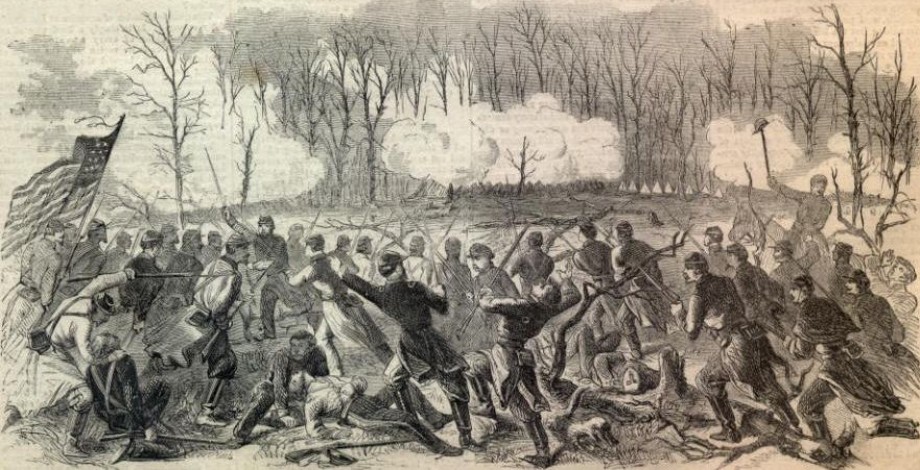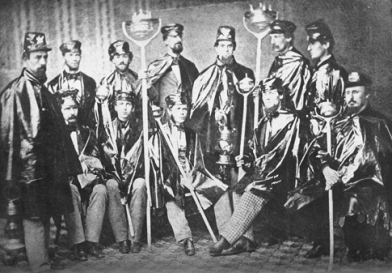During the 1860 Presidential election, St. Louis’ streets were host to multiple mass political organizations. Partisan marching clubs combined political mobilization and street theater with occasional brawling. The shocking election of the Abraham Lincoln, the candidate of the new anti-Slavery Republican Party, did nothing to lower the temperature in the contested city. Angry men in the city, and across the State of Missouri, vowed (according to their outlook) to refute, modify, or uphold the decision of the national ballot box. As the states of the Deep South moved to secession, in the border slave-holding state of Missouri people feared, and prepared for, civil conflict and the possibility of violence. In such an atmosphere the existing marching clubs did NOT disband. Instead they reorganized for the feared war ahead.
Ironically, the first of the political street fighters to organize militarily were (theoretically) the moderates, the Douglas Civil Guards, who had supported Senator Stephen Douglas, the “National Democrat” candidate in the recent election. On or about November 13th, 1860, only seven days after the election, the Douglas men reorganized themselves into the paramilitary “Constitutional Guards” to pursue future political and….. potentially….military goals. On November 23rd, their leader, sometime Missouri militia Colonel Thornton Grimsley wrote to sitting Missouri Governor Robert M. Stewart to inform the state’s chief magistrate that his men stood ready to fight Abolitionism and “Black Republicanism” by political or military means:
“The Douglas civil guards[,] a political organization which was under my command during the presidential contest[,] has been disbanded- some ten days since and have reorganized under the name of the constitutional guards. The present organization was made mainly to operate for our City election in april [sic] next and is composed as before of ten companies one in each ward of the city the enrollment of members is fully two thousand men and are commanded by a Col, Lieut Col, and Major with their staff officers same as on [sic] a military establishment.
The companies are officered just as the provisions of [Missouri’s state] military law [the state’s Militia Law of 1858] require so that while we claim to be and are in fact a political organization we can as once adopt the military costume shoulder arms and wheele [sic] into line as soldiers of our common country. Having given you the history of the organization of the Constitutional guards and the intentions of those who were instrumental in bringing them into existence which is to wipe out black republicanism from this congressional district I have an other pleasing duty to perform.
Which is to offer you the services of seven hundred to one thousand of the guards for any military service which as the Governor of the state you may command them to perform. The men are now under regular military drill which will be kept up while the distracted state of the country lasts or until [Abolitionist] fanaticism supplants good government or is driven not only from Kansas but from our beloved and now distracted country” [Original in the Special Collections of the Missouri State Archives]
Colonel Grimsley was a successful St Louis businessman, former state Senator, militia enthusiast and pro-slavery activist. While he had no professional military training (or combat experience) he had been a fixture of the various incarnations of the St. Louis militia for decades. While the “Constitutional Guards” were NOT (yet) a legally constituted militia regiment, it is clear the Colonel Grimsley viewed them as a military force in waiting, and one that might be used to combat the growing power of the Republican party and (in Grimsley’s view) Abolitionism in Missouri.
It is unlikely that Governor Stewart, a moderate “conservative” on Missouri’s political spectrum, welcomed Grimsley’s thinly veiled belligerence, and there is no record of a reply or any action to regularize the “Constitutional Guards’” militia status.
Colonel Grimsley had similar difficulty interesting Stewart’s successor, pro-Secession Governor Claiborne Fox Jackson in deputizing him (Grimsley) to attack Federal forces in St. Louis. Grimsley reportedly wrote Jackson in early 1861 (likely mid-January) proposing Jackson authorize him to capture the U.S. Arsenal at St. Louis “which he could safely do, as he had over one thousand men [presumably from among the “Constitutional Guards”], drilled, armed and ready for any work.” Grimsley also reportedly claimed that militia Brigadier General Daniel M. Frost, Commander of Missouri’s First [St. Louis] Military District was ready to cooperate with him on a prompt attack on the Arsenal.

BG Daniel M. Frost
Commander, 1st [St. Louis] Military District
Missouri Volunteer Militia (MVM)
Courtesy of the Missouri History Museum
“Major [William H. Bell, commander of the Arsenal] is with us, where he ought to be…..I shall therefor rest perfectly easy, and use all my influences to stop the sensationalists [among area secessionists] from attracting the particular attention of the [U.S.] government to this particular spot. The telegraphs you received were the sheerest “canards” of persons who, without discretion, are extremely anxious to show their zeal. I shall be thoroughly prepared with the proper forces to act as emergency may require. The use of [state militia] force will only be resorted to when nothing else will avail to prevent the shipment or removal of the arms [from the St. Louis Arsenal].”
Frost then turned to the true author of the recent reports of Federal activity at St. Louis “Grimsley, as you doubtless know, is an unconscionable jackass, and only desires to make himself notorious. It was through him that that [Minute Men President Charles] McLaren and [James] George made the mistake of telegraphing a falsehood to you.”
Ironically, while General Frost privately felt that Grimsley was too much a loose cannon to involve in the Governor’s official secessionist planning, Grimsley’s public reputation….at least in the press….was that of a moderate, perhaps even a Conditional Unionist.
The MISSOURI REPUBLICAN, the leading organ of the “National Democrats” in the St. Louis media market, viewed the “Constitutional Guards” as a resource for its political faction. At the time, the MISSOURI REPUBLICAN maintained a (somewhat erratic) Conditional Unionist editorial policy. The REPUBLICAN’s editors felt it proper not only to write approvingly of the “Constitutional Guards”, but to print the “orders” of its various ward paramilitary “Companies” on its editorial pages, to ensure that organized men which the REPUBLICAN believed supported its political policies could be properly mobilized.
The announcements to the right were published in the February 16, 1861 edition of the MISSOURI REPUBLICAN. They are the orders from Grimsley and his subordinate “officers” ordering the “Guards'” ten companies to mobilize that night. These postings were part of a series of articles to mobilize partisans for a rally on the evening of Febuary 16th in support of the “Constitutional Union” slate of candidates (generally viewed as a mix of “conservative”, i.e. pro-slavery, Unionists of varying enthusiasm) for election to the approaching state Constitutional Convention. Despite the MISSOURI REPUBLICAN’s official disdain for the Republican Party and the President-Elect, at the time the paper was advocating for a policy of state “neutrality” to keep Missouri on the sidelines of the developing conflict. The REPUBLICAN’s editors and other Conditional Unionists seemed to have viewed the “Constitutional Guards” (militant neutralists?) as a useful counterweight to pro and anti-secession militants active in St. Louis.
Unconditional Unionists were not so sure about Grimsley’s men. When, in January, there was a rumor of a possible raid on the Arsenal, Major Bell reportedly consulted with St. Louis Mayor Oliver Filley and Colonel Grimsley. In response Grimsley apparently attempted to exploit Bell’s fears and occupy the Arsenal. The Unconditional Unionist MISSOURI DEMOCRAT described the subsequent events with amusement, “the Constitutionals gallantly mustered a corps of picked volunteers, and proceeded to the Arsenal to reinforce Major Bell. On their arrival they were, as we are informed, most courteously received although that the honor of their presence within the walls was respectfully declined”.
Despite Grimsley’s militant intentions, and the “Constitutional Guards’” military pretensions, there is no evidence that before May 1861 the group’s members carried out any effective military function. This is likely the result of animosity between Grimsley and General Frost (despite their shared secessionist goals). Frost, a graduate of the West Point class of 1844 and a Mexican War veteran, was contemptuous of the amateur Grimsley. Also, as commander of the St. Louis military district Frost resented “Colonel” Grimsley contacting Governor Jackson directly, attempting to encroach on Frost’s role as area commander. For his part, Grimsley could have done what the openly secessionists Minute Men did, subordinate his organization to Frost and officially enlist his men in the Missouri Volunteer Militia (M.V.M.). But this would have (at best) made him a subordinate officer under Frost, and denied Grimsley the chance for individual glory as a war-time commander, something he had unsuccessfully sought as far back as the Blackhawk War in 1832.
The result was one more example of the mutual mistrust, miscommunication, and lack of cooperation which would plague the efforts of Missouri secessionist efforts through May. While Grimsely claimed that he could mobilize “over one thousand” of his men for service against Federal forces, there is no evidence he played any part in (or even had knowledge of) Frost and Jackson’s April-May moves to seize the Arsenal using militia forces. It is likely though, that some of Grimsley’s more secessionist “Constitutionals” decided to enlist in the new militia companies Frost raised in April and May in support of the planned attack. Indeed the newly raised Company “I”, of Frost’s 1st Regiment MVM was officially nicknamed the “Grimsley Guard” in his honor. Had the May militia muster continued past May 10, as it appeared it was going to, perhaps more of Grimsely’s man would have peeled off and filled Frost’s four planned state regiments.
As it was though, the majority of the “Constitutional Guards” were not at the militia drill site at “Camp Jackson” when Frost’s men were arrested on May 10. Instead, hundreds of Thornton Grimsley’s “drilled, armed, and ready” Guardsmen were at large, scatted over St. Louis. It is likely that these men…hostile to “Black Republicanism” and the “German element” prevalent among Federal volunteers…..played a role in the lethal violence which followed the arrest of the militia, and that continued though the days which followed.
Subsequently, the “Constitutional Guards” ceased to exist, as all non-Federal military formations in the city were ordered disbanded. As for the “Guardsmen” themselves, it is likely that a number when South, joining the secessionist Missouri State Guard or regular Confederate units. It is also likely that like other Conditional Unionists, other members of Grimsley’s organization joined the Federal volunteer regiments raised in Missouri, their support of Union overcoming their hostility to the incumbent Republican party.
Next time, we will examine St. Louis’ Minute Men paramilitaries….the true firebrands of secession. But that is a tale for another day.


























Recent Comments